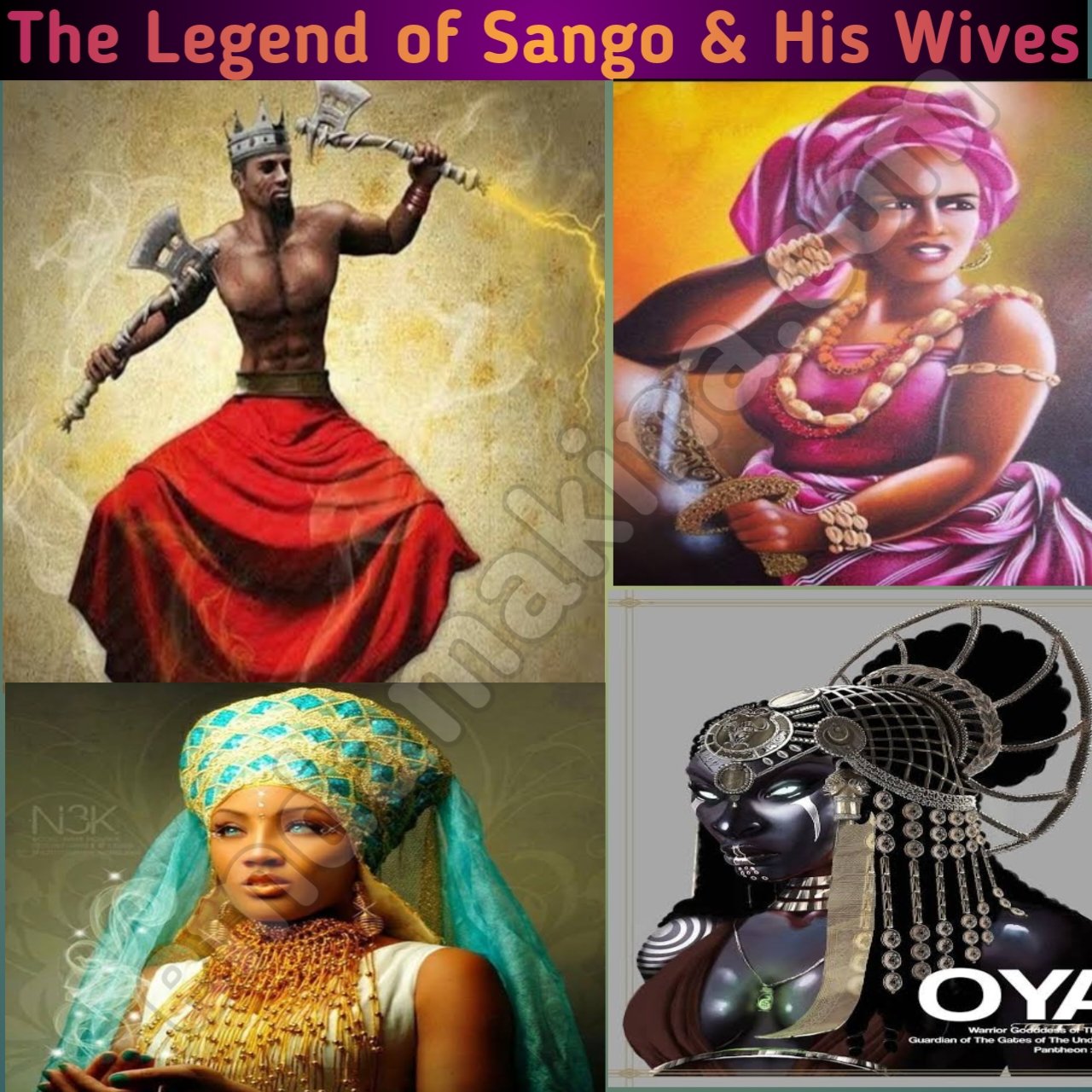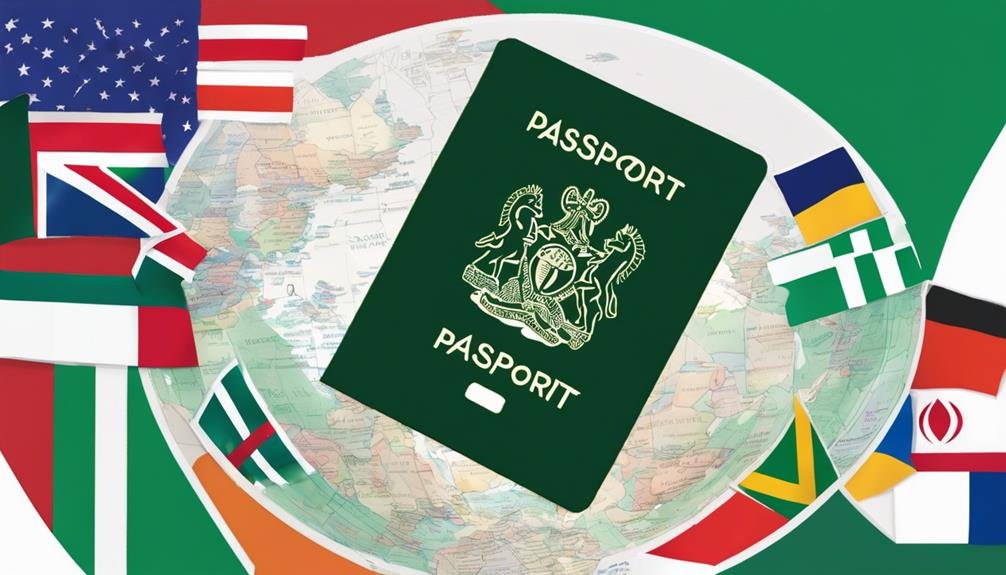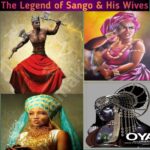I have always been fascinated by Yoruba legends and folklore. Of all the captivating tales, the story of Sango, the powerful god of thunder, and his wives remains my absolute favorite. Recently, I stumbled upon stunning photos depicting the Yoruba gods by the talented photographer James C. Lewis which rekindled my interest in retelling this legendary folktale.

Contents -Overview of Sango & Significance as a Yoruba Deity -Sango’s Rise to Power -The 3 Wives of Sango -Queen Oba -Queen Oshun -Queen Oya -Deceit, Rage, & Death -The Aftermath -Sango in Pop Culture -Visiting Key Sites from the Legend -More Great Resources
Overview of Sango & His Significance as a Yoruba Deity
Sango (also known as Jakuta, Chango, or Xango) stands as one of the most revered Yoruba deities. According to myth, he was the 3rd [1] Alaafin (king) of the medieval Oyo Empire which dominated much of southwestern Nigeria from the 14th to 18th century. Alongside governing the realm, Sango held supernatural command over thunder, lightning, and the sky.
After his dramatic death, Sango underwent an apotheosis to become the preeminent god of thunder and lightning within the Yoruba pantheon. His formidable powers, fiery temperament, and warrior nature made him one of the most feared yet celebrated Orishas (deified ancestors). Across Nigeria and regions of West Africa, worshippers revere Sango as a vital force of nature and noble guardian.
Beyond his homeland, Sango enraptured members of the African diaspora in the Americas too. The deity surfaced in syncretic religions like Santería, Candomblé, and Vodou where he intermixed with Catholic iconography of Saint Barbara and Saint Jerome. As displaced Yoruba slaves clung to their spiritual customs, Sango took on heightened importance as a bastion of cultural pride and retribution.
Clearly, Sango stands out as no ordinary god. But before his deification, he lived an extraordinary life as a mortal ruler.
Sango’s Rise to Power
Sango was born into Yoruba royalty at a time when the Oyo Empire expanded rapidly across southwestern Nigeria. He lived as a prince within the royal palace but faced stiff competition for the throne.
Key Names & Terms
- Oranmiyan: Sango’s father and founder of Oyo who opened the path for his son to rule
- Ajaka: Sango’s elder brother who preceded him as Alaafin but later got deposed for cowardice in battle
- Alaafin: King/ruler of Oyo
When Sango’s brother Ajaka faltered as a leader, their father Oranmiyan selected Sango to take charge instead. Ascending to the throne around 1550 CE, Sango the 3rd Alaafin quickly built upon his family’s gains. He stood out as intelligent, courageous, and adept in magic. But most strikingly, Sango deployed an aggressive military strategy that expanded Oyo’s borders substantially through continuous raids.
Professor Mason’s research confirms “Sango brought great prosperity to the Oyo Empire, unlike his meek brother.” Although a despot that resorted to violence, no one denied Sango’s effectiveness as a monarch. Within 7 short years under his reign, little threat remained to counter Oyo’s formidable imperial power.
The 3 Wives of Sango
Aside from his military and administrative feats, Sango made his personal mark through an unusual marital arrangement. Breaking protocol for kings at the time…
Sango took not one or two but THREE wives!
- Olori Oba – first wife
- Olori Oshun – second wife
- Olori Oya – third wife
In the sections below, we will explore the background of each wife along with her relationship dynamic with Sango:
Queen Oba
His first wife Olori Oba stood as Sango’s legitimate principal queen by traditional standards. As the initial spouse and mother to Sango’s heirs, Oba enjoyed primacy over subsequent additions to the conjugal quartet. She bore the honorific title Iya Mi meaning “my mother” – a term conveying her maternity of the royal bloodline.
Yet as we will see, Oba faced trouble maintaining Sango’s affections due to the allure of a charming newcomer…
Queen Oshun
Sango then took Olori Oshun as his second wife. Mythology identifies Oshun as an incarnation of the important Oshun River – forming her namesake – which runs through the Yoruba heartland. Like her riverine embodiment, Oshun gained repute as the preeminent goddess over fertility, beauty, arts, and feminine mystique.
Beyond her divine charms, Oshun whipped up meals so delectable that she seized Sango’s appetite and uppermost favor. Her outstanding talent in cooking catapulted Oshun into contention with elder wife Oba over their shared husband’s attention.
Queen Oya
The third and final addition arrived with Olori Oya, who joined Sango’s conjugal carousel as a concubine. Without undergoing a formal marriage ceremony or providing the standard bridal gifts, Oya lacked wifely status on paper. But her sheer magical abilities easily compensated…
Myths describe the storm goddess Oya as a versatile shapeshifter who wields the forces of wind, lightning, and thunder in tangent with her husband. Through cooperative use of their corresponding elemental powers, Sango and Oya merged into an indomitable duo that laid waste to all adversarial armies and kingdoms.
More than any other wife, Oya nurtured an intense intimate bond with Sango rooted in mutual infatuation and metaphysical synergy. With his guard lowered around his darling concubine, the enthralled king granted Oya privileged access to the fearsome divine spear known as Edun Ara (Thunderbolt). As the foremost symbol of Sango’s godly might, many devotees proclaim Oya as the one “who stood by his side faithfully until the bitter end.”
Deceit, Rage, & Death
At first, the three-wife arrangement seemed to unfold smoothly enough during Sango’s 7 year reign…
That is until jealousy, deceit, and betrayal turned the palace into a pressure cooker ready to explode!
As elder wife #1, Olori Oba stewed with mounting frustration over playing second-fiddle to the younger Oshun in cooking and charm.
To regain Sango’s favor, Oba turned to Oshun to pry loose her secret recipe for winning their mutual husband’s heart. But the crafty goddess refused to surrender her advantage.
Instead, Oshun intentionally misled Oba with fake advice – claiming Sango’s delight sprung from a macabre meal prepared with her own severed earlobe!
Blindly trusting her co-wife’s outrageous tip, Oba sliced off her whole ear to present the gruesome delicacy. But upon sight of the culinary abomination, Sango flew into a murderous rage assuming a botched assassination attempt by poisoning.
With tensions exploded, hell broke loose inside the palace…
In his fury, Sango summoned a catastrophic thunderstorm that killed Oba, Oshun, his other dependents, and eventually himself!
Mythologies diverge on precisely how the wives met their end during the calamity:
- Some versions say Oba got struck directly by Sango’s wrathful lightning blast
- Others instead recount Oba fleeing the palace only to trip and drown in a river that adopted her namesake
- Oshun also allegedly drowned after plummeting into another river that immortalized her as a prominent Yoruba water deity
But all narratives confirm the deadly climax left no survivors among Sango’s inner circle!
So in the end, neither wife could maintain the grand prize of Sango’s lasting affection once events took this disastrous turn…
The Aftermath
Following the tragedy, Yoruba oral traditions also scramble to explain Sango’s ambiguous final fate after the fires raged out:
- Certain stories claim Sango committed ritual suicide out of grief from losing his wives and dynasty
- But other sources suggest Sango rose straight into heaven amidst the magical maelstrom
- Popular legends merge the two outcomes by having Sango initially bury himself underground out of sorrow, only to become deified as supreme god of storm and thunder from the grave!
Regardless of ambiguous details, all Yoruba people today venerate Sango the god of thunder and lightning as their most esteemed deity and guardian! His cult worship spreads far and wide across not just Nigeria but other West African countries plus diaspora regions of Latin America and the Caribbean islands.
Fun Facts About Sango
- Sacred number = 4 or 6
- Sacred color = Red
- Favorite food = Amala (yam paste)
- Worship day = Ojo Jakuta (Thunder Day) = Wednesday
- Symbol = Double axe known as osé
- Manifests thunder and lightning
- Powers enhanced through special thunderstones
Sango in Pop Culture
Beyond formal spiritual practice, Sango periodically resurfaces in contemporary pop culture through books, movies, music, and arts that pay homage to the iconic legend:
Famous Depictions of Sango
** Films **
- Sango (1997) – a Nollywood/Nigerian film
- Sango: Return of the Legend (2021) – upcoming Nigerian film
** Books **
** Music **
- Sango (2009) – Afrobeat album
- Sango (2013) – ambient house album
Just recently, I stumbled upon the evocative photography series by James C. Lewis featuring the Yoruba pantheon. These stunning artistic renderings inspired me to revist and retell the grand fable of Sango – god among men and king among gods!
Visiting Key Sites from the Legend
As a bonafide history and culture buff, I long to embark on a pilgrimage across Nigeria and Benin to explore the most integral landmarks from Sango’s mythology:
Places to Visit
- Oyo, Nigeria: ruins of Old Oyo palace where Sango ruled and met his tragic ending
- Oshun River, Nigeria: sacred river embodied as Sango’s wife Oshun
- Oba River, Nigeria: river manifesting Sango’s first wife Oba
- Koso, Nigeria: alleged site where Sango committed ritual suicide
After paying homage to these vestiges of Sango’s ancient kingdom and final resting places of his wives, I hope to gather plenty of inspirational material to someday flesh out my dream book project retelling this captivating legend!
More Great Resources
Want to delve deeper? Be sure to check James C. Lewis’ gorgeous gallery of Yoruba divine imagery along with these other useful resources:
Sango and his queens (oriire article)
So in summary, I hope you enjoyed this extensive retelling of the mythos, history, and modern legacy behind Sango – Yoruba god of thunder! As one of Africa’s most venerated deities for over four centuries now, Sango’s dramatic story continues inspiring the spiritual imaginings and cultural identity of multiple nations worldwide. Please leave your thoughts below on this epic legend.
















Leave a Comment